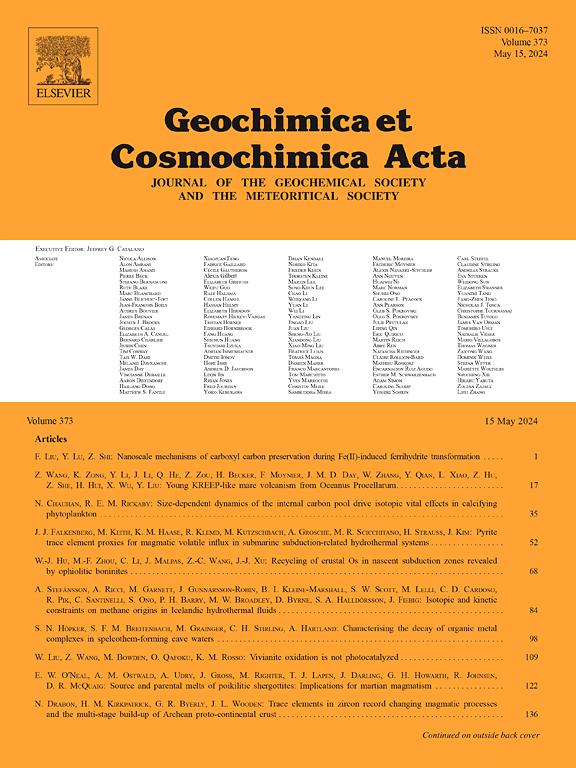Limited mercury (Hg) partitioning into bitumen and efficient gaseous Hg reabsorption during early thermal maturation of organic-rich mudrocks
IF 5
1区 地球科学
Q1 GEOCHEMISTRY & GEOPHYSICS
引用次数: 0
Abstract
Recent studies have looked into the impact of exposure to extremely high temperature, such as typifies contact metamorphism, on mercury (Hg) distributions in sediments, and observed significant Hg loss with increasing temperature. By contrast, sediment cores of Lower Jurassic organic-rich Posidonienschiefer (also known as Posidonia Shale) from the Lower Saxony Basin, Germany seemingly showed Hg enrichment after maturation related to basin subsidence and burial under more typical geothermal gradients. To investigate the apparent differences in Hg behaviour, we conducted a series of artificial maturation experiments on immature Posidonienschiefer samples, analysing Hg concentrations within rock residues and bitumen generated during early maturation stages. Thermal desorption profiles were used to track Hg speciation changes in the matured sediment. Our results show a progressive decrease in Hg concentrations in sediments with increasing thermal maturity throughout the experiments, which dominantly relates to released gaseous Hg with only a fraction of the Hg being partitioned into the bitumen (≤1% of the total initial Hg). Further experiments showed that gaseous Hg in closed vessels was rapidly (≤1 h) and efficiently (≥95 %) reabsorbed into the sediment during cooling. We speculate that our experiments may simulate some of the processes that drive Hg mobilisation and recapture occurring in contact aureoles, such as the rapid release and recapture of gaseous Hg. However, the Hg speciation changes that occur in our experiments and during natural burial maturation clearly differ. Specifically, the changes in Hg speciation in the natural system with burial-related maturation suggest that under those conditions organic matter associated Hg may instead transition into more thermally stable phases.
富有机质泥岩早期热成熟过程中汞在沥青中的有限分配和气态汞的有效再吸收
最近的研究调查了暴露在极高温下对沉积物中汞(Hg)分布的影响,例如典型的接触变质作用,并观察到随着温度的升高汞的显著损失。相比之下,德国下萨克森州盆地下侏罗统富有机质Posidonienschiefer(又称Posidonia Shale)沉积岩心在更典型的地温梯度下,与盆地沉降和埋藏有关的成熟后表现出汞富集。为了研究汞行为的明显差异,我们对未成熟的Posidonienschiefer样品进行了一系列人工成熟实验,分析了早期成熟阶段产生的岩石残留物和沥青中的汞浓度。利用热解吸剖面分析了成熟沉积物中汞的形态变化。我们的研究结果表明,在整个实验过程中,随着热成熟度的增加,沉积物中的汞浓度逐渐降低,这主要与气态汞的释放有关,只有一小部分汞被分配到沥青中(≤初始总汞的1%)。进一步的实验表明,封闭容器中的气态汞在冷却过程中被快速(≤1 h)和有效(≥95 %)重吸收到沉积物中。我们推测,我们的实验可能模拟了在接触光晕中驱动汞动员和再捕获的一些过程,例如气态汞的快速释放和再捕获。然而,在我们的实验中和在自然埋藏成熟过程中发生的汞形态变化明显不同。具体来说,随着埋藏相关的成熟,自然系统中汞形态的变化表明,在这些条件下,有机质相关的汞可能会转变为更热稳定的阶段。
本文章由计算机程序翻译,如有差异,请以英文原文为准。
求助全文
约1分钟内获得全文
求助全文
来源期刊

Geochimica et Cosmochimica Acta
地学-地球化学与地球物理
CiteScore
9.60
自引率
14.00%
发文量
437
审稿时长
6 months
期刊介绍:
Geochimica et Cosmochimica Acta publishes research papers in a wide range of subjects in terrestrial geochemistry, meteoritics, and planetary geochemistry. The scope of the journal includes:
1). Physical chemistry of gases, aqueous solutions, glasses, and crystalline solids
2). Igneous and metamorphic petrology
3). Chemical processes in the atmosphere, hydrosphere, biosphere, and lithosphere of the Earth
4). Organic geochemistry
5). Isotope geochemistry
6). Meteoritics and meteorite impacts
7). Lunar science; and
8). Planetary geochemistry.
 求助内容:
求助内容: 应助结果提醒方式:
应助结果提醒方式:


